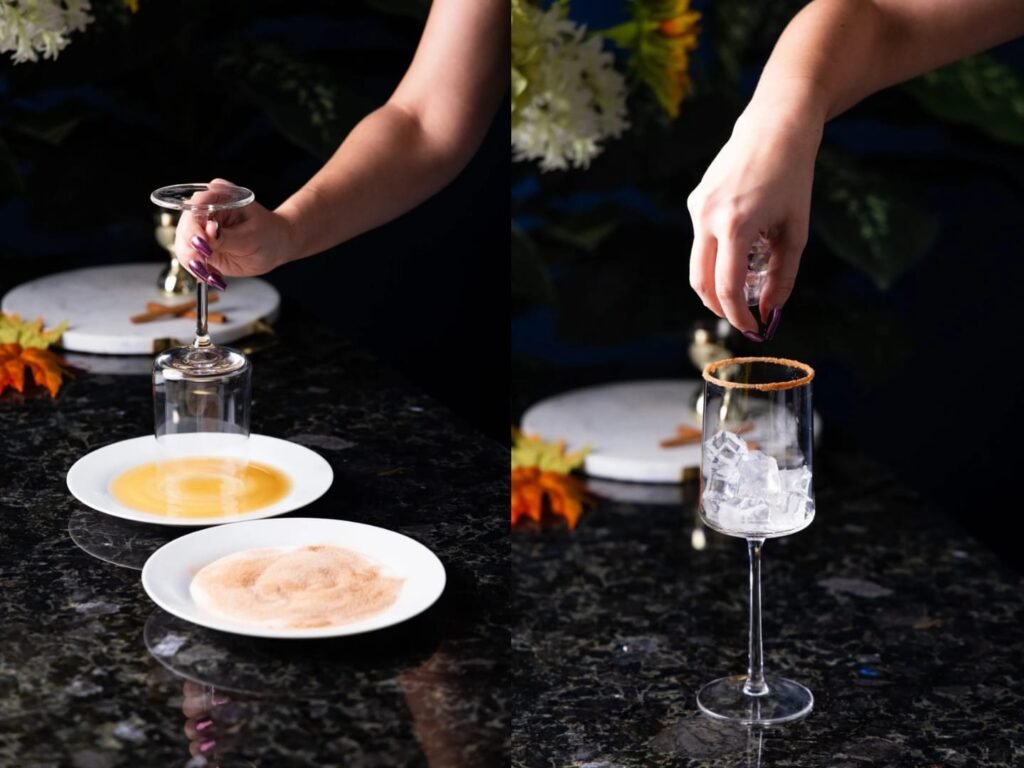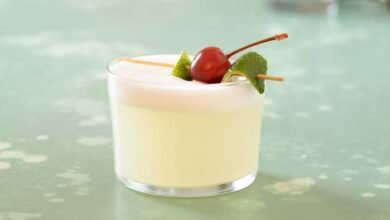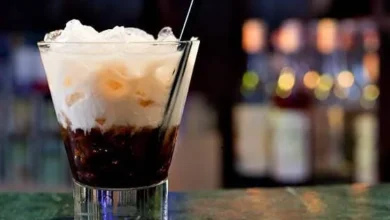Cozy Up with Apple Cider Aperol Spritz for Fall Cocktail

Among my favorite things about fall is checking out the local farmers market for fresh apples during the harvest season. Making homemade apple cider is totally worth the effort, as it’s incredibly versatile to use in cocktails. This year, I decided to whip up an Apple Cider Aperol Spritz, a perfect blend that captures the essence of the season.
Contents
- Apple Cider Aperol Spritz
- What Is Aperol?
- Can I use Campari instead of Aperol?
- What is the difference between Champagne and Prosecco?
- What is the difference between Aperol and Campari?
- What Kind of Soda Water for Aperol Spritz?
- History of the Aperol Spritz
- Ingredients You’ll Need:
- My Favorite Glassware
- How to make an Apple Cider Aperol Spritz
- Make apple cider (if using homemade)
- Notes from Raise Your Glass
- FAQs about Aperol Spritz and Apple Cider Spritz
- Apple Cider Aperol Spritz
Apple Cider Aperol Spritz
Aperol, one of my favorite cocktail ingredients, is similar to Campari but with a less bitter taste. Its vibrant burst of orange-red hues reminds me of autumn leaves, making it naturally paired with the fall staple, apple cider. I knew this delicious apple aperol spritz recipe would combine the best of both worlds – the cozy comfort of apple cider and the sophisticated flair of a spritz.
What Is Aperol?
Aperol is an Italian aperitif known for its bright orange color and unique, bitter taste. As an aperitif, it’s typically more dry than sweet, which means a small amount goes a long way in adding flavor to your apple cider aperol cocktail.
Can I use Campari instead of Aperol?
While Aperol and Campari are similar in some ways, Campari is more bitter than its orange counterpart. Substituting one for the other would significantly change the taste of the drink. Based on my experience, I do not recommend using Campari in this recipe.
READ: Lavender Lemon Drop Cocktail
What is the difference between Champagne and Prosecco?
Both Champagne and Prosecco are popular sparkling wines, but they have distinct origins and characteristics. True Champagne comes from the Champagne region of France and can only be labelled as such if it’s produced there. Prosecco, on the other hand, hails from Northeastern Italy, specifically the Veneto and Friuli-Venezia Giulia regions.
While Champagne can be made from various grape varieties, Prosecco is primarily produced from the Glera grape variety. These differences contribute to their unique flavors and make each suited for different types of cocktails.
What is the difference between Aperol and Campari?
Campari and Aperol are both owned by the Campari group, but these two liqueurs are not the same. Campari is a key ingredient in classics like the Americano, Boulevardier, and Negroni Sbagliato. It’s beloved for its bright red color and bittersweet flavor that adds depth to cocktails.
Aperol is much like Campari in its use as an apéritif, but unlike its deep red counterpart, Aperol’s ingredients create an orange-hued liqueur. Aperol’s key ingredients include bitter rhubarb, vegetal gentian root, and cinchona. The tree bark that gives tonic water its characteristic bitterness also contributes to Aperol’s unique flavor profile, making it a versatile choice for lighter, more refreshing drinks.
READ: Aperol Negroni
What Kind of Soda Water for Aperol Spritz?
Any plain soda water will work for an Aperol Spritz. The purpose of the soda water is to add a bit of carbonation and to dilute the drink slightly. Here are some popular options:
- Club soda: This is a classic choice and often has a slightly salty taste that can enhance the overall flavor.
- Sparkling water: Many brands offer sparkling water with different flavor profiles, but plain is best for this cocktail.
- Seltzer water: Similar to club soda, seltzer water provides carbonation without adding any additional flavors.
History of the Aperol Spritz
I was always curious about the history of classic drinks. Turns out, the apple cinnamon spritz has a fascinating story! The Barbieri brothers, Luigi and Silvio, debuted this apéritif in 1919 at the International Fair in Italy. The name “spritz” comes from a French word, “apéritif”, which is often shortened to “apéro”.
The Aperol Spritz as we know it today was developed in the 1950s and quickly became a popular Italian cocktail. It’s common to see friends meet up for an Aperol Spritz in northeastern Italy.
The classic Aperol Spritz is made with three parts Prosecco, two parts Aperol, and a splash of soda water. It’s served over ice in a wine glass and garnished with an orange slice. While Aperol cocktails are always favorites of mine, there’s something extra special about enjoying them in the autumn. This traditional Italian cocktail gets a delicious fall twist when you swap out the Prosecco for apple cider.
Ingredients You’ll Need:
- Aperol: You can use any brand you like.
- Spiced apple cider: This gives it that extra fall flavor, but classic apple cider works too!
- Club soda: Just a splash for a bit of carbonation.
- Garnish: Apple slices, cinnamon sticks, and a thyme leaf add a beautiful touch.
- Cinnamon sugar: A sprinkle on the glass rim for a delicious twist.
My Favorite Glassware
I personally love using the Schott Zwiesel Pure Drinkware Collection from Frontgate for this cocktail. While they might be an investment, they’re definitely worth it and a great addition to any bar collection.
How to make an Apple Cider Aperol Spritz

- First, rub the rim of a stemless wine glass with a slice of lemon, then dip the glass in a cinnamon sugar mixture. Set aside.
- Add ice to the glass until it’s almost full. Then pour in the spiced apple cider, followed by the Aperol. Carefully add the champagne to the glass.

- Top off the mixture with a splash of club soda. Gently stir your Apple Cider Aperol Spritz. For the finishing touch, garnish with a slice of apple, a cinnamon stick, or a thyme leaf. This cocktail is perfect for a Thanksgiving meal or any fall occasion.
Make apple cider (if using homemade)
To make your own cider, start by washing, de-coring, and quartering your apples. Place them in a large pot or Dutch oven. Add a quartered orange, brown sugar, allspice, cloves, star anise, a cinnamon stick, nutmeg, and a few cardamom pods. Pour in enough water to cover the ingredients, then stir until everything is well combined.

Simmer the mixture in your Dutch oven over low heat for about four hours. Occasionally use a wooden spoon to crush the apples until they reach a texture similar to applesauce. Finally, strain the mixture through a fine-mesh sieve lined with cheesecloth to get your homemade apple cider.
READ: Bloody Caesar Cocktail
Notes from Raise Your Glass
- Adding a cinnamon sugar rim to your glass enhances the spiced, fall flavor while sipping this cocktail.
- You can use either classic or spiced apple cider, depending on your preferred flavor intensity.
- While the apple cider spritz recipe calls for champagne, you can easily substitute it with Prosecco for a more budget-friendly option.
- Use a cinnamon stick to stir your cocktail. This not only looks elegant, but also infuses an extra layer of spiced flavor into your drink.
Final Words
So, gather your friends, fire up the grill, and raise a glass of this delightful Apple Cider Aperol Spritz. It’s the perfect way to celebrate the changing seasons.
FAQs about Aperol Spritz and Apple Cider Spritz
Can you spritz with apple cider?
Absolutely! Apple cider spritz is a delicious fall variation of the classic Aperol Spritz. It’s a refreshing and flavorful drink that combines the sweetness of apple cider with the bitter-sweetness of Aperol.
What is an apple spritzer made of?
An apple spritzer typically consists of apple cider, sparkling water, and sometimes a splash of fruit juice or liqueur for added flavor. It’s a light and refreshing drink perfect for warmer weather.
Is Aperol Spritz very alcoholic?
The alcohol content of an Aperol Spritz depends on the proportions of the ingredients, but it’s generally considered a moderate-strength cocktail. Aperol itself has an alcohol content of around 11%, and it’s typically mixed with Prosecco or sparkling wine, which also contain alcohol.
Is apple cider good with prosecco?
Yes, apple cider pairs surprisingly well with Prosecco. The sweetness of the cider complements the bubbly and slightly dry character of the Prosecco, creating a refreshing and balanced drink.
Is an Aperol Spritz served on the rocks?
Traditionally, an Aperol Spritz is served over ice, but it can also be enjoyed on the rocks. Serving it on the rocks will result in a slightly different taste experience, as the ice will melt more slowly, diluting the drink at a slower pace.
What flavors go well with Aperol?
Aperol pairs well with a variety of flavors. Here are some popular options:
- Classic: Orange slice
- Fall: Apple cider, cinnamon, thyme
- Fruity: Grapefruit, blood orange
- Herbal: Rosemary, mint
- Bitter: Tonic water
What does Aperol Spritz taste like?
An Aperol Spritz has a unique and refreshing taste. It’s slightly bitter from the Aperol, with a sweet and bubbly character from the Prosecco or sparkling wine. The overall flavor is balanced and easy to drink.
Apple Cider Aperol Spritz
Course: Cocktails1
cocktail5
minutes178
kcal5
minutesRaise Your Glass to delightful Apple Cider Aperol Spritz. It’s the perfect way to celebrate the changing seasons.
Ingredients
1 ounce Aperol
3 ounces Spiced Apple cider
3 ounces Champagne
Splash of club soda
Sliced apples, cinnamon sticks and thyme leaf
For Cinnamon Sugar 3 Tablespoons Granulated Sugar + 1 teaspoon Ground Cinnamon
Directions
- First, rub the rim of a stemless wine glass with a slice of lemon, then dip the glass in a cinnamon sugar mixture. Set aside.
- Add ice to the glass until it’s almost full. Then pour in the spiced apple cider, followed by the Aperol. Carefully add the champagne to the glass.
- Top off the mixture with a splash of club soda. Gently stir your Apple Cider Aperol Spritz. For the finishing touch, garnish with a slice of apple, a cinnamon stick, or a thyme leaf. This cocktail is perfect for a Thanksgiving meal or any fall occasion.






